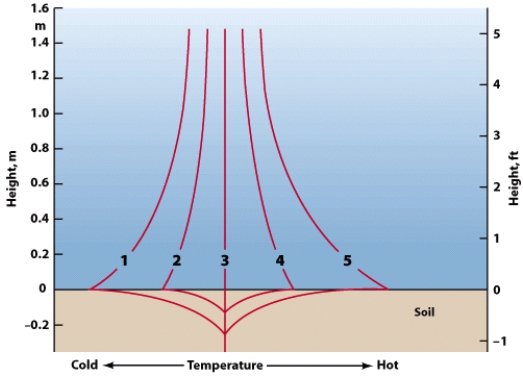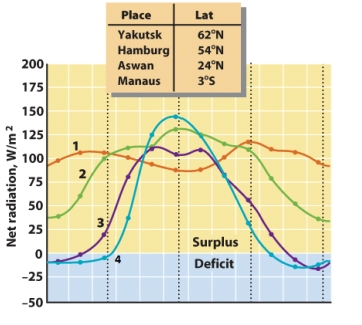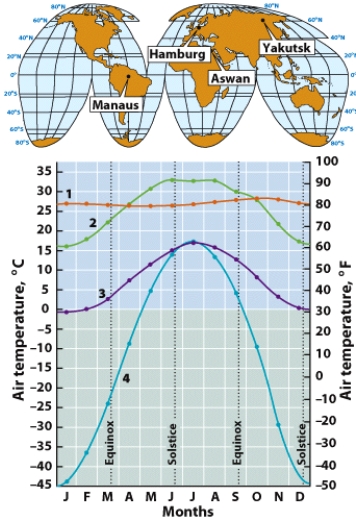Correct Answer

verified
Correct Answer
verified
Multiple Choice
Which of the following contributes to global warming?
A) tropospheric aerosols
B) human-induced cloud changes
C) methane
D) human-induced land cover alterations
Correct Answer

verified
Correct Answer
verified
Multiple Choice
Which of the following surfaces would tend to heat up most, given the same amount of insolation?
A) bare light color soilsl
B) a pond
C) a meadow
D) concrete
Correct Answer

verified
Correct Answer
verified
Multiple Choice
Which of the temperature profiles on this figure most closely resembles the situation you would expect shortly after dawn? 
A) 1
B) 2
C) 3
D) 5
Correct Answer

verified
Correct Answer
verified
Multiple Choice
Ground surface temperatures tend to be ______ than the temperature of the overlying air.
A) warmer
B) cooler
C) less extreme
D) more extreme
Correct Answer

verified
Correct Answer
verified
True/False
Water has a smaller heat capacity than land surfaces.
Correct Answer

verified
Correct Answer
verified
Multiple Choice
On high mountains, air pressure will be _______ the adjacent lowlands.
A) higher than
B) lower than
C) the same as
Correct Answer

verified
Correct Answer
verified
Multiple Choice
During the daytime, air temperature tends to ______ closer to the ground, and during the night it tends to _______ closer to the ground.
A) increase / increase
B) increase / decrease
C) decrease / decrease
D) decrease / increase
Correct Answer

verified
Correct Answer
verified
Multiple Choice
The temperature change in equatorial regions from January to July is __________ the change in mid-latitude regions.
A) much larger than
B) much smaller than
C) slightly larger than
D) about the same as
Correct Answer

verified
Correct Answer
verified
True/False
Latent heat is the energy that is absorbed by a substance when it changes state.
Correct Answer

verified
Correct Answer
verified
Multiple Choice
Examine the annual net radiation patterns shown in this figure. The curve for the city of Yakutsk at 62ᵒ N latitude is labeled: 
A) 1
B) 2
C) 3
D) 4
Correct Answer

verified
Correct Answer
verified
Short Answer
Because of their lower ________, urban surfaces like asphalt tend to absorb more insolation than rural surfaces like forest.
Correct Answer

verified
Correct Answer
verified
Short Answer
Changes in tropospheric aerosols, cloud cover, and land cover associated with human activities all tend to _______ global temperatures.
Correct Answer

verified
Correct Answer
verified
Multiple Choice
According to the IPCC report of 2007, the possibility that recent global warming is a result of human activity is considered:
A) unlikely
B) likely
C) very likely
D) certain
Correct Answer

verified
Correct Answer
verified
Multiple Choice
Temperature inversions can cause problems for agriculture because they may contribute to:
A) drought
B) flood
C) soil erosion
D) frost
Correct Answer

verified
Correct Answer
verified
Multiple Choice
Examine the monthly mean air temperature patterns shown in this figure. The curve for the city of Manaus at 3ᵒ S latitude is labeled: 
A) 1
B) 2
C) 3
D) 4
Correct Answer

verified
Correct Answer
verified
Multiple Choice
For mid-latitude locations, air temperatures tend to be highest on the:
A) summer solstice
B) winter solstice
C) vernal equinox
D) autumnal equinox
Correct Answer

verified
Correct Answer
verified
Multiple Choice
Closely spaced isotherms on a map indicate a:
A) large temperature gradient
B) small temperature gradient
C) high pressure zone
D) low pressure zone
Correct Answer

verified
Correct Answer
verified
True/False
Average January temperatures are much colder in parts of Siberia than in Antarctica.
Correct Answer

verified
Correct Answer
verified
Multiple Choice
Which of these locations would be likely to experience the smallest annual temperature range?
A) Manaus, Brazil (3 degrees south latitude)
B) Aswan, Egypt (24 degrees north latitude)
C) Hamburg, Germany (53 degrees south latitude)
D) Yakutsk, Siberia (62 degrees north latitude)
Correct Answer

verified
Correct Answer
verified
Showing 61 - 80 of 157
Related Exams